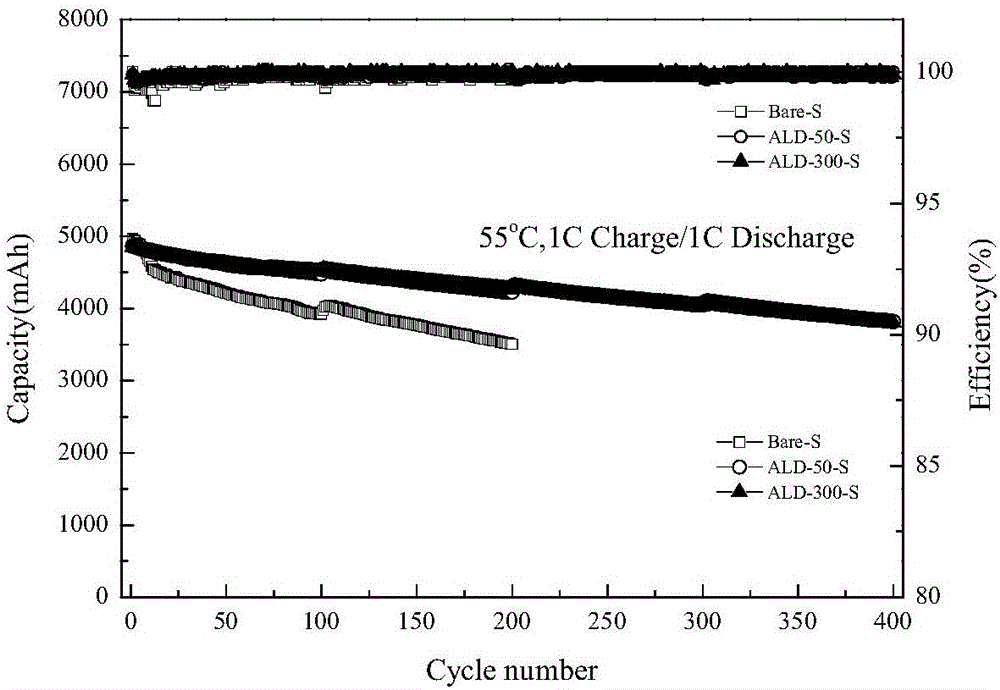Atomic layer deposition modified lithium-ion battery and preparation method thereof
A technology of atomic layer deposition and lithium-ion batteries, which is applied in vapor phase deposition manufacturing, electrode manufacturing, battery electrodes, etc., can solve the problems of cycle stability and high temperature resistance that cannot meet the space working environment, and achieve high temperature and cycle stability. , controllable chemical composition, and low growth temperature
- Summary
- Abstract
- Description
- Claims
- Application Information
AI Technical Summary
Problems solved by technology
Method used
Image
Examples
preparation example Construction
[0031] The second embodiment of the present invention also provides the preparation method of the lithium-ion battery modified by atomic layer deposition, including: step 1, using atomic layer deposition technology, depositing a modification layer on the surface of at least one of the positive and negative electrodes; step 2 1. Prepare a lithium ion battery by using the positive and negative electrodes.
[0032] Further, the deposition process includes: the pressure in the cavity is 1-2 Pa, the temperature is 50°C-500°C, such as 100°C, 180°C; the pulse time of the precursor is set to 5~30ms, and the flushing time of the precursor is set to 5~30 s, such as using TMA and H 2 O was used as the precursor, the pulse time of the precursor was set to 10 ms, the flushing time of TMA was set to 10 s, and the pulse time of the H 2 The flushing time of O was set to 15 s, and the carrier gas flow was 10-30 SCCM.
Embodiment 1
[0034] Mix and stir 60 grams of N-methylpyrrolidone and 3 grams of polyvinylidene fluoride until the viscosity of the mixed solution changes less than 3% within 10 minutes, then add 1 gram of microspherical superconducting carbon black with a particle size of less than 5 microns, 1 g Carbon nanotubes with a tube length of less than 100 microns and 1 gram of flake-like conductive graphite were stirred until the viscosity of the mixture changed by less than 3% within 10 minutes, and finally 94 grams of LiNi after 25 cycles of atomic layer surface modification were added 0.80 co 0.15 al 0.05 o 2 materials, stirred until the viscosity of the mixture changed less than 5% within 10 minutes, and then the above solid-liquid mixture was coated on an aluminum foil, and vacuum-dried at 100°C for 24 hours to obtain a positive electrode. Mix and stir 100 grams of distilled water and 1.5 grams of sodium carboxymethylcellulose until the viscosity of the mixture changes less than 3% within 10...
Embodiment 2
[0036] Mix and stir 60 grams of N-methylpyrrolidone and 3 grams of polyvinylidene fluoride until the viscosity of the mixed solution changes less than 3% within 10 minutes, then add 1 gram of microspherical superconducting carbon black with a particle size of less than 5 microns, 1 g Carbon nanotubes with a tube length of less than 100 microns and 1 gram of flake-like conductive graphite are stirred until the viscosity of the mixture changes by less than 3% within 10 minutes, and finally 94 grams of nickel-cobalt binary cathode material is added, and the mixture is stirred until the viscosity of the mixture changes by less than 1% within 10 minutes. 5%, and then the above solid-liquid mixture was coated on an aluminum foil, and vacuum-dried at 100°C for 24 hours to obtain a positive electrode. Mix and stir 100 grams of distilled water and 1.5 grams of sodium carboxymethylcellulose until the viscosity of the mixture changes less than 3% within 10 minutes, then add 3 grams of mic...
PUM
| Property | Measurement | Unit |
|---|---|---|
| particle diameter | aaaaa | aaaaa |
Abstract
Description
Claims
Application Information
 Login to View More
Login to View More - R&D
- Intellectual Property
- Life Sciences
- Materials
- Tech Scout
- Unparalleled Data Quality
- Higher Quality Content
- 60% Fewer Hallucinations
Browse by: Latest US Patents, China's latest patents, Technical Efficacy Thesaurus, Application Domain, Technology Topic, Popular Technical Reports.
© 2025 PatSnap. All rights reserved.Legal|Privacy policy|Modern Slavery Act Transparency Statement|Sitemap|About US| Contact US: help@patsnap.com



